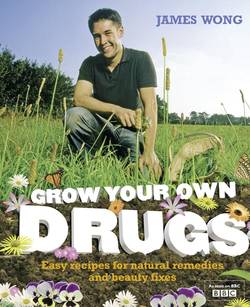Читать книгу Grow Your Own Drugs: A Year With James Wong - James Wong - Страница 7
GROWING GROWING YOUR OWN PHARMACY
ОглавлениеIf you’ve never made a recipe in your life before, this book is a great place to start. And if you’ve never grown a plant before, even better. I want to cast away the dusty stereotypes that too often surround gardening, and in particular herbal remedies, and show you just how easy it is to get out there and start cultivating your very own living pharmacy – even if you are convinced you are a non-gardener. With just a couple of clippings from your backyard, you can create simple remedies for everyday ailments, spa-like beauty treatments and other practical products that bring a shine to furniture, scent to your home, or even get rid of your cat’s fleas.
Nowadays, getting hold of medicinal plants and seeds is becoming ever easier. Even the most run-of-the-mill garden centres now stock a surprisingly broad range of the plants you need for just a couple of pounds. More than just the traditional parsley, sage and thyme, too: even my local high-street florist sells such weird and wonderful things as blackcurrant-scented sage, pineapple mint and Japanese wasabi plants (the source of the spicy green paste that accompanies sushi). Of course, once you have many of these planted up in your garden or window box, they often spread themselves all over the place via underground runners or seeds, popping up in even the most unexpected of places. But the most exciting thing about medicinal plants is that so many of these are common culinary ingredients: you need only look at the back of your refrigerator or spice rack for the plants you need. Simply pop a leftover stick of lemongrass in a glass of water on a window sill, or sprinkle a couple of grains from that jar of fennel seeds in a pot of compost, and in just a couple of months you will have a supply of fresh, organic, air mile-free ingredients for all sorts of remedies.
The tricky thing about so much choice, however, is that it can seem enormously daunting for a beginner. Where on earth do you start? The best way to simplify the whole business is just to pick plants that are useful at treating the afflictions you are prone to (see here) and which have a scent or flavour you like. As there is almost always a selection of several different plants that share similar properties, you have the luxury of picking and choosing whichever one(s) you like the most for a particular ailment.
Now, if you have never tried angelica, tansy or lemon balm before, let alone know what they look like, I have a simple recommendation: look round your local public botanic or herb garden; you’ll find it’s a great source of ‘scratch and sniff’ inspiration. Walking beside the beds and borders, you can get to know the look, smell and habit of plants you may otherwise have only read about in books or seen on TV, with neat little labels to guide you along the way, to decide which you like best. My favourite such garden is the Chelsea Physic Garden, just down the road from me, amidst the hustle and bustle of central London. It’s hidden behind high walls, and you’ll think you’ve stumbled across a small piece of undiscovered land, though it’s actually been a virtual theme park for medicinal plant enthusiasts for more than three centuries; it was set up in 1673 to teach the doctors of the Royal Hospital, at a time when botany was a necessary part of medical training. Here, little labels dot the borders and, in true Harry Potter style, explain the plants’ uses – ‘once used by the Aztecs for dye’, for example, and ‘used to treat malaria’.
By keeping your eyes out at local gardens like these, you can pick up invaluable tips on what will grow well in your own backyard. If you spot a creeper thriving on a south-facing wall, for example, it is likely to do the same in a similar site at home for you. Conversely if you see a bush looking a bit forlorn in a boggy patch, you might want to think twice about planting it around your pond at home. This way, you are learning from the experiences of others; think of it as horticultural espionage.
I am passionate that plant-based medicine is so much more than its stereotype – a bit namby pamby, a bit hippy-ish. It deserves more respect than that: many contain powerful chemical ingredients and should therefore be treated fwith as much respect as conventional drugs. Plants can genuinely be a useful way to treat all sorts of minor, everyday complaints, but it is vital that you first receive a professional medical diagnosis, especially if you have an underlying medical condition, are taking medication, or are pregnant. Ifyou think you may be sensitive to any of the ingredients, do a 24-hour skin test first to check for allergies. It is also important to use common sense when using plant-based remedies: don’t give any of the remedies to children under the age of 2, or to children under 16 unless specified as safe in the recipe. (See also the special section for ‘Kids’, see here).
But enough of that. Let’s get started. Your own living pharmacy is just a few steps away.
